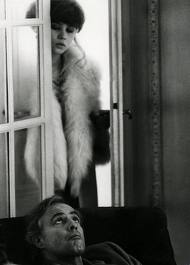Last Tango in Paris: Difference between revisions
No edit summary |
No edit summary |
||
| Line 8: | Line 8: | ||
---- | ---- | ||
[[File:LastTango.jpg|left]] | [[File:LastTango.jpg|left]] | ||
''' | '''Artists:''' Bernardo Bertolucci (director), Marlon Brando (actor) and Maria Schnieder (actress) | ||
'''Confronting Bodies:''' Italian, American and British governments, religious organizations in several countries. | '''Confronting Bodies:''' Italian, American and British governments, religious organizations in several countries. | ||
| Line 14: | Line 14: | ||
'''Dates of Action:''' 1972-1974 | '''Dates of Action:''' 1972-1974 | ||
''' | '''Locations:''' Bologna, Italy; London, England; Cincinatti, Ohio | ||
'''Description of Artwork:''' ''Last Tango in Paris'' is described in two different ways. Those who oppose the film's "obscenity" have called it, "obscene content offensive to public decency, characterized by an exasperating pansexualism for its own end, presented with obsessive indulgence catering to the lower instincts of the libido, dominated by the idea of stirring unchecked appetites for sexual pleasure, permeated by scurrilious language." Others have called it "the most powerful erotic movie ever made." <P> | '''Description of Artwork:''' ''Last Tango in Paris'' is described in two different ways. Those who oppose the film's "obscenity" have called it, "obscene content offensive to public decency, characterized by an exasperating pansexualism for its own end, presented with obsessive indulgence catering to the lower instincts of the libido, dominated by the idea of stirring unchecked appetites for sexual pleasure, permeated by scurrilious language." Others have called it "the most powerful erotic movie ever made." <P> | ||
[[File:Bertolucci.jpg|right]] | |||
'''The Incident:''' ''Last Tango in Paris'' survived its first attempt at censorship, brought by a private prosecutor in Bologna in 1972. However, the Bologna Court of Appeals banned, confiscated and destroyed copies of the film. Bertolucci, the films producer, Alberto Grimaldi, Marlon Brando and Maria Schneider, were arrested, recieved two month prison sentences and fined 30,000 lire. The case was retried several times between 1972 and 1976. Prosecutors argued that the work should not be protected as a work of art, the courts agreed, and the ban stood. In Cincinatti, Ohio, the city's chief officer watched the film and declared that it was obscene. Fearing legal action, the theater's director terminated the film's engagement after seven weeks. The film was also placed on the U.S. Catholic Conference's list of condemned films. In England, the film passed through the British Board of Film Censors, however, was brought to trial under the Obscene Publications Act. ''Last Tango'' was not banned but was forbidden to air on television until the early 1990s. <P> | |||
'''Results of Incident:''' The film earned international recognition. Up to 1998, it has not been allowed to show on Italian screens. In 1998 a bill crossed the Italian Parliament that would deny the Censorship Commission the power to ban films. <P> | '''Results of Incident:''' The film earned international recognition. Up to 1998, it has not been allowed to show on Italian screens. In 1998 a bill crossed the Italian Parliament that would deny the Censorship Commission the power to ban films. <P> | ||
Revision as of 22:38, 29 November 2011
Date: 1972 - 1974
Region: Europe
Subject: Explicit Sexuality
Medium: Film Video
Artists: Bernardo Bertolucci (director), Marlon Brando (actor) and Maria Schnieder (actress)
Confronting Bodies: Italian, American and British governments, religious organizations in several countries.
Dates of Action: 1972-1974
Locations: Bologna, Italy; London, England; Cincinatti, Ohio
Description of Artwork: Last Tango in Paris is described in two different ways. Those who oppose the film's "obscenity" have called it, "obscene content offensive to public decency, characterized by an exasperating pansexualism for its own end, presented with obsessive indulgence catering to the lower instincts of the libido, dominated by the idea of stirring unchecked appetites for sexual pleasure, permeated by scurrilious language." Others have called it "the most powerful erotic movie ever made."
The Incident: Last Tango in Paris survived its first attempt at censorship, brought by a private prosecutor in Bologna in 1972. However, the Bologna Court of Appeals banned, confiscated and destroyed copies of the film. Bertolucci, the films producer, Alberto Grimaldi, Marlon Brando and Maria Schneider, were arrested, recieved two month prison sentences and fined 30,000 lire. The case was retried several times between 1972 and 1976. Prosecutors argued that the work should not be protected as a work of art, the courts agreed, and the ban stood. In Cincinatti, Ohio, the city's chief officer watched the film and declared that it was obscene. Fearing legal action, the theater's director terminated the film's engagement after seven weeks. The film was also placed on the U.S. Catholic Conference's list of condemned films. In England, the film passed through the British Board of Film Censors, however, was brought to trial under the Obscene Publications Act. Last Tango was not banned but was forbidden to air on television until the early 1990s.
Results of Incident: The film earned international recognition. Up to 1998, it has not been allowed to show on Italian screens. In 1998 a bill crossed the Italian Parliament that would deny the Censorship Commission the power to ban films.
Source: Censorship, A World Encyclopedia, ed. D. Jones

